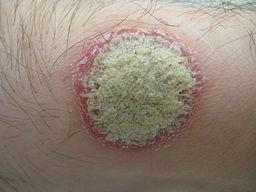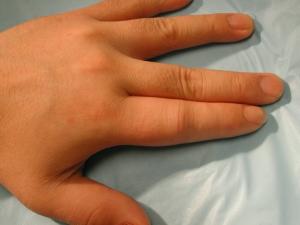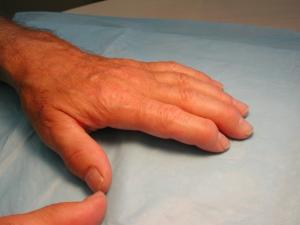Overview

Provided Dr James Heilman from Wikipedia.
Psoriasis is an autoimmune disease (immune system attacks the patient) of the skin. It is characterized by raised red areas of the skin called plaques. The plaques typically have what is called scales that flake off the skin similar to dandruff. The plaques favor the scalp, elbows, knees and trunk. They can be localized to a few plaques or may encompass 70% or more of the total skin surface in more serious cases.
FAQs
How is arthritis related to psoriasis which is a skin condition?
Psoriatic arthritis is also an autoimmune disease and occurs in up to 30% of people with psoriasis. The genetic risk factors are similar to psoriasis but a bit different and complex. The arthritis normally follows the appearance of the psoriasis plaques but in a few people, the arthritis begins first. Often a dermatologist will suspect that a person with psoriasis has psoriatic arthritis and refer the person to a rheumatologist to confirm the diagnosis. It is important to remember that just because someone with psoriasis has joint pain that it does not mean that they have psoriatic arthritis as conditions like osteoarthritis or fibromyalgia are much more common.
What kind of joint symptoms are seen in psoriatic arthritis?
 Psoriatic arthritis is an inflammatory form of arthritis meaning a person affected will be stiff in the morning typically over 30-45 minutes and feel less stiff with activity. Swelling is also common and one can see what is called dactylitis or so called “sausage” finger or toe due to the diffuse swelling of the joints and surrounding tissues.
Psoriatic arthritis is an inflammatory form of arthritis meaning a person affected will be stiff in the morning typically over 30-45 minutes and feel less stiff with activity. Swelling is also common and one can see what is called dactylitis or so called “sausage” finger or toe due to the diffuse swelling of the joints and surrounding tissues.
 In the hands, all of the joints can potentially be affected including the joints on the ends of the fingers called the distal interphalangeal joints or DIPs (note swelling of the DIP joint of the index finger of hand in in picture). Almost any large joint can be affected as well with swelling, pain and gradual joint damage due to loss of cartilage. In some people the back can be inflamed leading to stiffness, pain, and gradual loss of motion. Spine involvement with psoriatic arthritis is called spondylitis and can be similar to a condition called ankylosing spondylitis.
In the hands, all of the joints can potentially be affected including the joints on the ends of the fingers called the distal interphalangeal joints or DIPs (note swelling of the DIP joint of the index finger of hand in in picture). Almost any large joint can be affected as well with swelling, pain and gradual joint damage due to loss of cartilage. In some people the back can be inflamed leading to stiffness, pain, and gradual loss of motion. Spine involvement with psoriatic arthritis is called spondylitis and can be similar to a condition called ankylosing spondylitis.
Usually psoriatic arthritis affects only 2-5 joints, so-called pauciarthritis. Occasionally there is only one joint affected (monoarthritis) and is some people multiple joints (polyarthritis) might be affected and their psoriatic arthritis may resemble rheumatoid arthritis.
People with psoriatic arthritis can also get enthesitis. The enthesis is an area where connective tissue such as tendons, ligaments, or the tissue surrounding the joint called the capsule inserts into bone. These areas can be inflamed and cause pain without obvious joint swelling. These areas of inflammation can be seen on imaging studies such as an MRI scan or by ultrasound. Several of the faculty at the University of Washington are trained in musculoskeletal ultrasound, including Dr. Scott Pollock, and can do an enthesitis exam if needed.
Who gets psoriatic arthritis?
Genes are important in psoriasis and psoriatic arthritis but the genetics are complicated as noted previously. Unlike rheumatoid arthritis where more women than men get the disease, psoriatic arthritis has an equal male to female ratio. The age of onset is diverse and even kids can get psoriatic arthritis. Other risk factors include being overweight and having diffuse psoriasis, psoriasis of the scalp, or psoriasis involving the skin folds (so-called inverse psoriasis).
Smoking increases the risk of psoriasis and psoriatic arthritis in the general population BUT if you have psoriasis and smoke the risk of psoriatic arthritis is not increased; the so-call smoking paradox. Smoking can reduce the efficacy of medications that treat psoriasis and psoriatic arthritis and it also is a risk factor for cardiovascular disease which is already increased in these diseases (discussed below) so smoking cessation is important for overall management of psoriatic arthritis.
Can psoriatic arthritis affect other areas besides the joints?
Besides the skin, 80% of people with psoriatic arthritis can have finger and toe nails might have pitting or ridging or nail separation called onycolysis.
About 8% of people with psoriatic arthritis can develop eye inflammation called uveitis or iritis that would require the care of an ophthalmologist (eye specialist). Symptoms include eye redness, pain with looking at light (photophobia), and decreased vision. It is typically treated with eye drops and resolves in two weeks and rarely causes permanent visual loss although there are exceptions.
Like other chronic inflammatory diseases, psoriasis and psoriatic arthritis are associated with an increase in cardiovascular disease including heart attacks. Chronic inflammation leads to accelerated atherosclerosis (hardening of the arteries) which leads to heart attacks. Treatment of inflammation should lessen this risk (successful treatment of rheumatoid arthritis has been shown to significantly reduce the risk of cardiovascular disease in this group of people).
How is psoriatic arthritis treated?
For mild disease where one or two joints are affected, an anti-inflammatory medication might be sufficient. Local corticosteroid injections might also be useful.
For more persistent disease or where more joints are affected, an immunosuppressant medication might be necessary. Many of these will treat the joints and the skin. The first medication is often methotrexate, an older medication, that is taken once a week often with a vitamin called folic acid. It takes 4-8 weeks before it begins to work and the dose is often stared low and increased gradually up to 25 mg per week. It can also be given by subcutaneous self-injection using an insulin syringe.
If something more than methotrexate is needed the following medication are now available to treat psoriatic arthritis and psoriasis:
TNF inhibitors:
- Etanercept (Enbrel)
- Adalimumab (Humira)
- Golimumab (Simponi)
- Infliximab (Remicaide)
IL17 Inhibitors:
- Secukinumab (Cosentyx)
- Ixekizumab (Taltz)
IL12/23 inhibitors
- Ustekinumab (Stelara)
PDE4 inhibitors
- Aprimilast (Otezla)
JAK inhibitor
- Tofacitinib (Xeljanz)
Are there other issues that are important in people with psoriatic arthritis?
- As noted smoking cessation is important.
- Making sure your immunizations are up to date to reduce the risk of infection while on medication that suppress the immune system
- Use of some medications requires testing for a history of hepatitis B or TB exposure
- Make sure other risk factors for cardiovascular disease such as cholesterol and other lipids are addressed.
- Take good care of yourself with adequate rest and reasonable diet; lose weight if your BMI is high (body mass index)
Overall, great strides have been made in understanding and treating psoriatic arthritis in the last 10 years. In the future we will have even more tools to make precision medicine a reality. We will be able to know which genes are activated and choose medications based on this information to more effectively treat people with this disease



